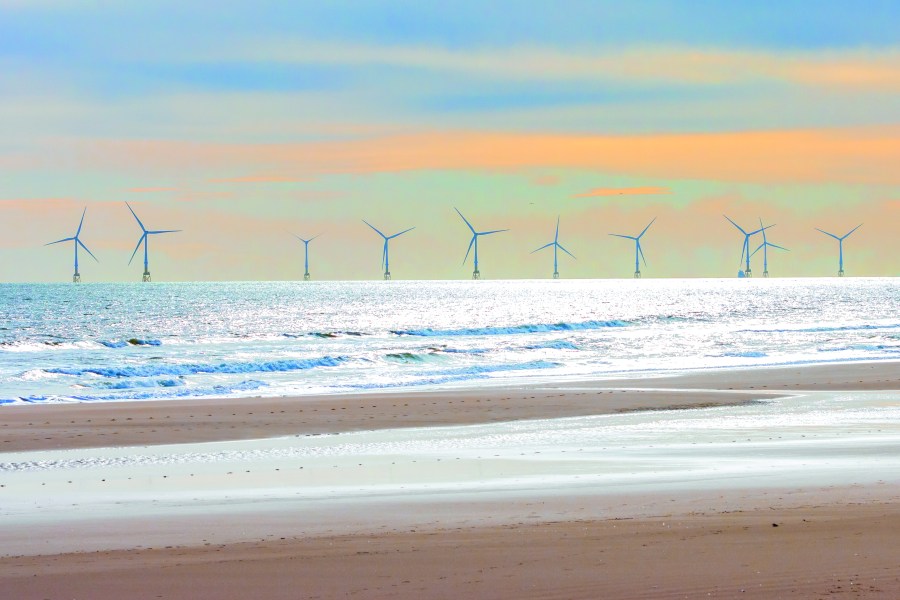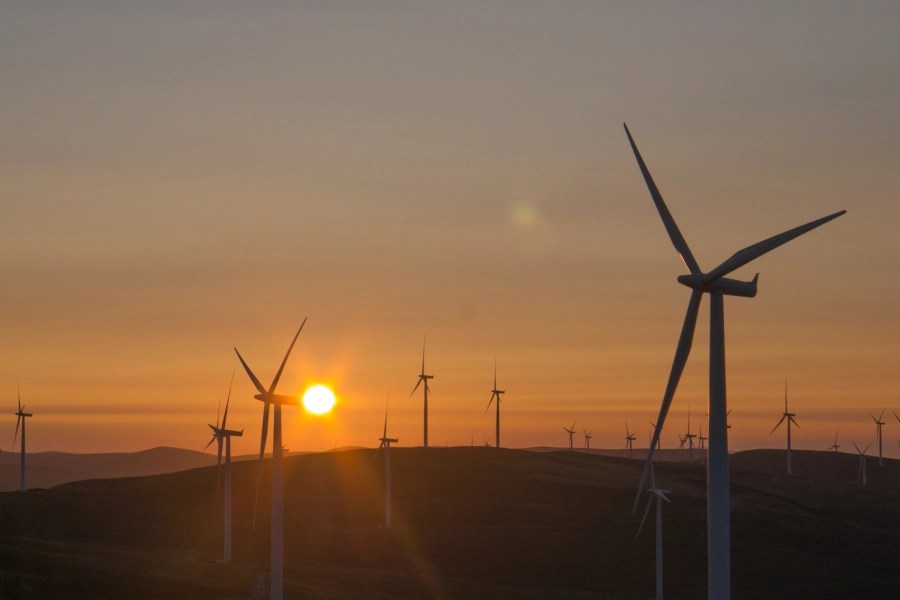In the first of a regular comment series, Mary-Ann Ochota ponders the dilemma of wind farms and where to build renewable energy infrastructure.
‘Eyesores!’ thundered my friend, shaking a fist at the wind farms on a hillside in the Scottish borders, ‘It’s ruined. How could they? To this place!’ We had laboured uphill for the view, but for the next 15 minutes he angrily ate his lunch with back turned, an act of protest with a cheese and ham sandwich.
Confession time: I actually quite like the sweeping, architectural power of a wind turbine. I find a hillside of them beguiling and quite serene. We scurry below, while the mighty ‘mills glide steadily on, cycling through the ether. Up close, their swooshing feels vast and visceral. Which for me, makes interacting with enormous energy infrastructure strangely similar to my experience of wild upland walking, buffeted and awestruck and alive. I do appreciate that I’m possibly in a lonely corner on this one.
On one level, my friend is obviously right – forty-odd turbines with kilometres of hard-surfaced service track snaking between them will profoundly change your experience of the hills. Many walkers rightly and passionately defend natural beauty, and want areas they enjoy to be protected from human development.

Mary-Ann backpacking in Scotland. Photo: Mary-Ann Ochota
The places we love are often not ‘pristine’ landscapes. Almost every UK hillside has been radically altered by human activity – they’d be covered by trees otherwise. And especially in Scotland, many of those remote hillsides aren’t untouched, they’re depopulated: thousands of communities were forcibly evicted from the Highlands and Islands in the Clearances of the 1700s and 1800s, and rural communities are still shrinking.
Green-on-green conflict
But even if it’s not wilderness, our type of ‘wild’ has huge value – for nature and for people. Upland landscapes are some of the best candidates for nature restoration – replanting sphagnum and rewetting the peat, reintroducing the right trees to the right places, balancing the webs of animal, plant and insect life, protecting us from flooding, erosion and slowing biodiversity loss. The government has committed to managing 30% of UK land for nature by 2030. They claim they’ve achieved 28% – research published last year conducted by RSPB scientists indicates that the amount of land effectively protected is closer to 5%.
It’s estimated that by 2050 the UK will consume more than twice the amount of electricity than we do today. In 2020 onshore wind – those land-based turbines – generated 11% of the UK’s electricity, enough to power 18.5 million homes for a year. Achieving net zero will only be achieved by reducing consumption but also by increasing production of clean, sustainable energy.
Wind is part of that, there’s no getting away from it. So how do we avoid green-on-green conflict, when we build renewables infrastructure at the expense of the uplands? Could the turbines be at sea, rather than on hillsides?
On land or on water?
Offshore, wind turbines can be bigger and taller. New technology means they don’t even need to be drilled into the seabed, but can be on floating anchored platforms, energy islands in the sun. The UK government’s own target is to triple offshore wind capacity by 2030. But offshore wind farms are expensive to build and maintain and take longer to construct. And so there’s still political and economic appetite to build onshore, on hills.

An offshore wind farm seen from the coast. Photo: Shutterstock
Maybe it’s because infrastructure specialists who may have never visited the uplands see empty space as unexploited opportunity. ‘Woah,’ they marvel. ‘All that bit up here,’ their hands drift north, past Hadrian’s Wall, and west, past Birmingham, ‘there’s nothing there.’
Plans for quick-to-build, easy-to-maintain onshore wind farms start to coalesce in their minds. ‘Why bother building in the middle of the ocean, when we could just drill them into the hills and mountains of Scotland and Wales?’
Some of the more appallingly inappropriate applications for wind farms are hard to excuse – the proposed Glenshero wind farm in the Monadhliath Mountains was thankfully rejected earlier this year, following objections from the John Muir Trust, Cairngorns National Park Authority, NatureScot, Mountaineering Scotland and the Highland Council, to name a few.
A fine balance
We also need to support rural communities and make sure they’re heard by decision-makers – although that in itself might take us into contested ground. In a 2021 response to a Scottish national planning consultation, Durness Community Council expressed concern that current wild land protections in Sutherland were restricting economically beneficial development.
So there’s work to be done. We need to robustly defend wild land. But the bottom line is that turbines are here to stay; a pragmatic response to a life-threatening climate crisis, an important part of tackling the cost of living and key to alleviating security fears around our energy sovereignty.
If we add our voices too readily to the turbine-haters’ tribe, we might find ourselves on the wrong side of history. Yes, some turbines will be in places where you don’t want to see them while eating your sarnies. They might make you choke, but don’t turn your back on them altogether – those spinning, swooshing giants can be part of a nature-focused future.
Mary-Ann is a broadcaster, anthropologist and keen hillwalker. She’s the hillwalking ambassador for the British Mountaineering Council, a trustee for the John Muir Trust and a fellow of the Royal Geographical Society. These are her personal opinions. Find her on Instagram and Twitter @MaryAnnOchota.
Main image: the Clyde Wind Farm. Credit: Ronald Turnbull







